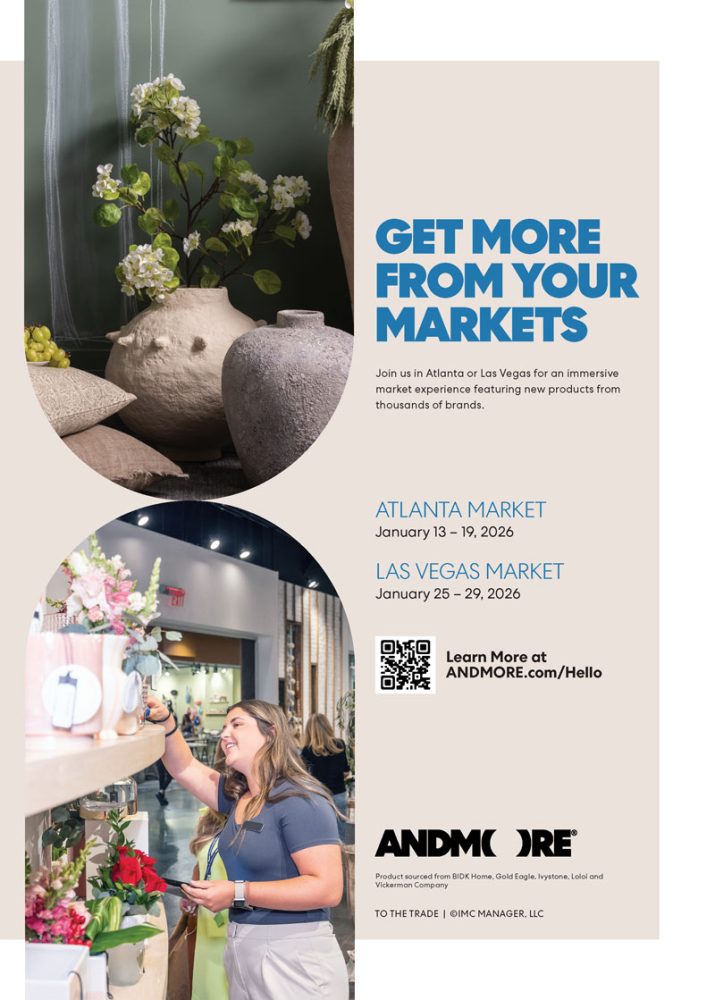Learning the proper principles, elements, mechanics and techniques to achieve floral design mastery will help you to expand your skills and truly enjoy the artform. Sharon McGukin AIFD, Smithers–Oasis Design Director, shares her knowledge on the foundation of floral design.
Source Smithers-Oasis
Read Full Article Here:

We’ve all heard the old adage – you must learn the rules – to break the rules, but I think Pablo Picasso had the best idea. He said “Learn the rules like a pro, so you can break them like an artist.”
While it may seem simple enough to drop flowers in a vase and call it an arrangement, even more pleasure can be derived once you’ve learned the fundamentals of design.
Floral design mastery
To acquire a professional level of skill, you must start with the basics. The Principles and Elements of Design are the technically correct manner of placing materials in a design. Learning the proper principles, elements, mechanics and techniques to achieve floral design mastery will help you to expand your skills and truly enjoy the artform.
The stability and beauty of a flower design begins with its foundation and radiates up and out. That foundation is established by adhering to the Principles and Elements of Design. Focused learning leads to producing quality work. Artistry inspires expression, and professionally made designs inspire repeat sales.
It may seem okay to create something that looks beautiful, but isn’t well made, as long as it holds up for the duration of a video or presentation. But, what are the long-term effects for the audience? For a floral retailer, arrangements must be structurally sound enough to survive delivery and being moved about in the home. Poorly made designs have the potential to discourage consumers from making future flower purchases.
Flowers are often given to wedding guests to take home. If the flowers haven’t been arranged in a water source, their lifespan is cut short by dehydration. The disappointed recipient doesn’t say “your flowers don’t last very long,” they say “flowers don’t last very long.” Frequent ‘flower failures’ like these are damaging to future sales industry-wide.
Shortcuts short-circuit
When one learns to design by shortcuts, they short-circuit their potential. Learning to design professionally is rewarding, but does require an investment of time and talent. There are many ways to accomplish a professional design. One must first learn the rules in order to choose how best to apply them.
I was taught the Principle and Elements of Design in my early years in a flower shop. Today, some designers refer to the guidelines as Elements and Principles of Design. Possibly because the Elements are the characteristics we physically see. I, and many other floral designers, were traditionally taught that the strength and stability of an arrangement is most important. That solidity begins with the Principles such as balance, proportion, and unity. The artistic Elements of personal taste such as color, form, and texture come next. Neither set of natural rules are limited to floral design, and can be found universally in all forms of design.
The building blocks
The Principles of Design are fundamental guidelines to aesthetic design that govern the organization of the elements and materials in accordance with the laws of nature.
Let’s first consider the Primary Principles:
1. Harmony
2. Proportion
3. Balance
4. Dominance/Emphasis
5. Rhythm
6. Contrast
7. Unity
They are defined as:
Harmony: the selection of materials that form a unified composition. All parts are consistently related.
Proportion: the size relationship of one part of a floral design to another, or one portion to the whole. The size and relationship of the flowers to each other. The size of the flowers in comparison to the container that holds them. A traditional rule of proportion for tall arrangements is that the flowers are 1 and ½ times the height of the container. A ratio of 1.5:1 for a low arrangement such as a mound or cube design. For a vase arrangement, the vase is 1/3 to ½ the height of the design.
Inverse proportion is achieved when the container is the 1 and ½ half times measure and the flowers take the smaller space on top. Sometimes botanical materials cascade over the sides of the container to increase the visual size of the flowers.
Balance: a state of equilibrium, actual or visual; a feeling of three-dimensional stability
Actual balance: a design is stable and well-balanced.
Visual balance: a design looks balanced although it isn’t from a physical perspective. Sometimes an arrangement looks stable, but an off-kilter placement of materials makes the design physically or visually unbalanced.
Asymmetrical: a scalene triangle that features three unequal sides and angles. An unequal volume of materials on either side of the vertical axis.
Symmetrical: design materials placed equally on either side of the central axis for visual and physical weight distribution. The elements are placed in the same position on each side in this mirror image design, sometimes called Bilateral Symmetry or Formal Balance.
Dominance/Emphasis: the placement of sharply contrasting materials of size, color, or texture to draw the eye to a specific focal area of the design.
Rhythm: visual movement through a composition usually achieved through repetition, gradation, or pattern.
Contrast: placing two visually different or opposing elements in a design to emphasize or accentuate their differences, allowing a feature of the design to stand out.
Unity: oneness of purpose, thought, style, and spirit. A cohesive relationship of all parts. A sense of connectedness. The feeling of a single unit.
Now, the Secondary Principles:
1. Scale
2. Focal Area/Focal Point
3. Repetition
4. Accent
5. Depth
6. Transition
7. Variation
8. Opposition
9. Tension
10. Simplicity
Scale: the relative ratio of size, or the relationship of the size of a composition to the surrounding area or environment. For example, a small altar arrangement might be in proportion to its container. When placed in a large cathedral its small size is dwarfed. It looks out of scale.
Focal area/ focal point: the area of greatest visual impact or weight; the center of interest to which the eye is naturally drawn.
In a parallel-style design, the focal area becomes more of a focal plane than a point. Forms, colors, and textures are concentrated at the base plane, or platform of growth. Lending a sense of gravity and stability to the foundation from which the other materials extend.
Repetition: repeated or recurring elements grouped together to create rhythm within a composition. A sense of unity, organization and cohesiveness in a design by repeated color, texture, form, or pattern.
Accent: a distinctive, regularly occurring, but subordinate pattern, motif, or color. Often recognized in the dominant or focal area of a design.
Depth: the placement of materials at different levels in and around an arrangement to create a three-dimensional visual-depth effect.
Transition: a smooth, rhythmic visual movement creating gradual degrees of change between one or more the elements. Connecting one part of a design to another.
Opposition: contrast between elements which are counterpoint in relation to each other. This contradiction adds vitality to a design. Creates tension.
Variation: the use of different, dissimilar, or contrasting elements in a design. A change or slight level of difference in the attributes or characteristics of elements in a design.
Tension: the dynamic, aesthetic quality achieved by opposing materials that implies energy in a design.
Simplicity: the elimination of unnecessary detail.
Artistic tools
The Elements of Design: The Elements of Design are defined as the directly observable components, ingredients, and physical characteristics of design.
Artistic tools that personalize the arrangement to express the message of the designer.
The Elements of Design
1. Form
2. Line
3. Space
4. Texture
5. Size
6. Color
7. Pattern
8. Fragrance
Creative use of these elements establishes a unique look. Learning why and how to apply these characteristics increases your skill and helps you to develop your own ‘signature style.’
Form: the shape or configuration of an individual component of the composition. The overall, three-dimensional, geometric shape or configuration of a composition.
In other words, a specific 3-D area defined by outline or contrast. Geometric form is the basis of Western design, such as triangle, circle, or square. Floral forms exist in three dimensions – height, width, and depth.
Line: visual path that directs the eye movement through a composition. Helps to create the basic outline or strength of a design. These lines may be straight (Static), curved (Dynamic), or a combination. They may be actual (physically there) or implied (created in the mind’s eye). You can look at a design and visualize an imaginary line connecting.
A strong, straight Static Line creates visual stability in a design, while a dramatic Dynamic Line creates visual energy.
Space: the area in, around, and between the components of the design, defined by the three-dimensional area occupied by the composition.
In this 3-D form there can be Physical Space – the area filled by botanical materials. Negative Space – the area where there are no materials. Or a void – the empty space that visually separates areas of positive space.
Materials such as curly willow, branches, or grasses can be used to expand the size of the design by connecting empty negative space to the physical space that is filled with flowers. The design now fills a larger area from tip-to-tip of the radiating materials. This technique often expands the saleable size of the arrangement.
Texture: the surface quality of a material, as perceived by sight or touch. Texture is the richness of design. The eye is drawn by the contrast of tactile qualities.
Size: the physical dimensions of line, form, or space. The size of floral materials must be in proportion to the container and the whole composition in scale with the environment where it is placed.
Color: visual response of the eye to reflected rays of light. Described as hue, value, or shade.
Hue, denotes the origin of the color we see. The dominant color family.
Tint, a hue or mixture of colors to which white is added. For example, pastels.
Value, the overall intensity of how light or dark a color is.
Shade, a color or mixture of colors to which black has been added.
Tone, the lightness or darkness of a hue to which gray (equal amounts of black & white) has been added.
Color is the most eye-catching element. The color harmony of a design is often the personal choice of either the designer or the customer.
Pattern – repetition of line, space, texture, or color combinations. Through repetition, anything can be turned into a pattern. For example, the silhouette of a flower against a background creates a delicate pattern.
This visual element comes in two types of pattern:
Natural – pattern that occurs naturally.
Man-made – pattern created by a human, used in art for structural or decorative purposes.
Fragrance – a sweet or pleasing odor, or scent perceived by the sense of smell. Smell is the element that triggers memory. Nature uses the fragrance of flowers to attract pollinators. Floral fragrances attract flower buyers, as well. Designers must consider possible allergies, food aromas, and personal preference when using fragrant flowers.
Increase your knowledge of design
Invest in yourself with this floral professional training resource. Purchase the book and read it from cover to cover. The AIFD Guide to Floral Design. Terms, Techniques, and Traditions. Price: $129.99. ISBN: 9780764364259. American Institute of Floral Designers. www.aifd.org. The Texas State website https://tsfa.org also offers good information.
Please share this Floral Hub Blog (for readers), or How we Bloom podcast (for listeners), with other designers. The podcast is available on Buzzsprout, Spotify, Apple Podcasts, similar apps. Both are available at oasisfloralproducts.com along with products, ideas, and other valuable floral information.























